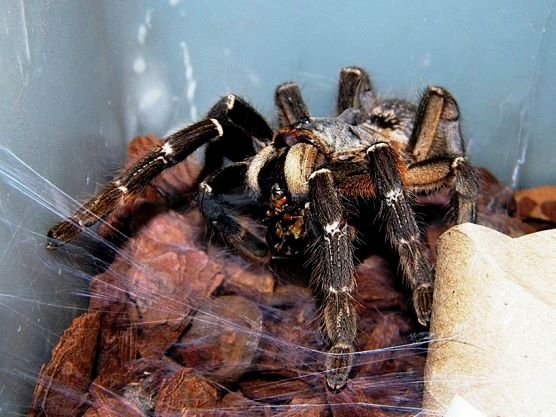Baboon spider

Author: Ivan Lätti
Photographer: Piet Grobler
Baboon spiders are venomous ground-dwellers of Africa. A local subfamily of the tarantulas, the bite from their fangs is painful or itchy for a few days, usually not more serious than that. The feeling is bad when considering that the black fangs may exceed 1 cm in length.
There are several genera and numerous species of baboon spiders forming part of the Harpactirinae. Some are well-known, others not, holding surprises and causing fantasies. South Africa has eight genera and 44 species of baboon spiders occurring in all parts of the country. Seven known species from four genera live in the Kruger National Park.
The common name is earned by general hairiness and the padded feet resembling baboon fingers. These spiders are found, often unexpectedly near a bush in the veld, not so much in gardens. They occur in many diverse habitats like scrubland, grassland and bushveld, their ecologies in many cases still poorly known.
There are horned baboon spiders, featherleg baboon spiders, trapdoor baboon spiders, starburst baboon spiders, tree-dwelling baboon spiders, genera of small, medium and large species, “common” ones and genera comprising only a single species. Some are good-looking although so hard to see.
Baboon spiders eat enthusiastically, their diet varied, therefore healthy. It includes beetles, cockroaches, small rodents, lizards and more, depending on what comes near, especially at night.
Attention is sure to be focussed when facing a baboon spider of 15 cm raising its front legs. (The king baboon spider of East Africa has a 20 cm leg span.) Some baboon spiders can also stridulate, i.e. rub certain body parts together for producing a sound spelling belligerence, serving to intimidate. In the case of baboon spiders these parts are the jointed femurs of some legs producing a hissing sound; they have, of course, spare legs to stand on while others hiss.
These warning signs indicate that a bite may be imminent for overpowering a suitably sized prey or defending against all comers, size not an issue.
Go to https://www.baboonspideratlas.co.za for contributing to the study of baboon spiders (Wikipedia; https://www.sanbi.org; http://www.krugerpark.co.za; https://www.bca.org.za; www.africansnakebiteinstitute.com).

